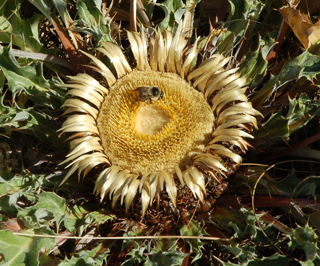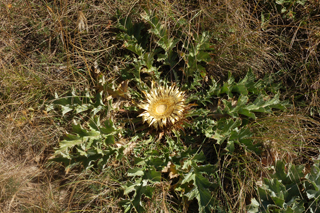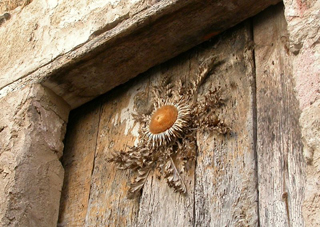Human Flower Project
Monday, August 20, 2007
Star of the Cevennes ~ Cardabelle
Picnicking in rocky Southern France, Roger Sanderson comes upon a barometer in bloom.

Cardabelle (Carlina acanthifolia), in the Herault, France
Photo (detail): Roger Sanderson
Nearly one year ago, we did some hunting around Olargues in the Herault region of Southern France, searching for the wild cardabelle plant. We’d read about how country people of the region had used this native thistle both for carding wool and predicting the weather. The cut flowers, so we’re told, open in the sun and begin closing up when rain is on the way. (A word to tourists: museums, even European ones, keep more reliable hours and locations than do wildflowers.)
But now we hear from Roger Sanderson, a photographer in Lincolnshire, England. “I was lucky enough to find a few plants growing high in the Cevennes above Anniane this summer,” he writes. And we are lucky enough to present a few of his gorgeous pictures (for more, see Roger’s portfolio on Flickr.
 Cardabelle
Cardabelle
(Carlina acanthifolia)
w. of Lodeve, France
Photo: Roger Sanderson
“The flowers I found were near the peak of Saint Baudille which is east of Saint Guilhelm le-Desert and west of Lodeve. We drove up a rocky track to find a site for a picnic, before the sun got too hot. While we where trying to photograph butterflies we came across a patch of the flowers on very poor stony ground.” See what chasing butterflies can accomplish?
“I recognised them from tiles and paintings that were in the Gite we stayed in. They were in full bloom and being pollinated by at least two types of bumble bees.”
Our reading suggests that Carlina acanthifolia blooms in spring and early fall, so we’re a bit surprised to hear Roger found this patch flowering in summertime. Again, wildflowers don’t necessarily go by the book. And with reference to our post from yesterday, about mythological Clytie who turned into a “sunflower,” we now wonder if she perhaps didn’t become a cardabelle, as this plant is actually a Mediterranean native (some varieties of Carline thistle are even “violet”—a word that described Clytie’s bloom in some translations of Ovid).
 Cardabelle barometer
Cardabelle barometer
Photo: Fritz Geller-Grimm, via wiki
Roger Sanderson adds, “In the ancient fortified Templar town of Couvertoirade, there were lots of dried Cardabelle tacked onto the doors of the houses and (touristy) shops, in spite of the prohibition on cutting them. The French have a more relaxed attitude to edicts from government than other countries.” (We’d be eager to hear what our French visitors have to say.)
Roger noted that he’d spotted the same plaster cardabelle we photographed in Pezenas. But to the butterfly chaser, by all rights, goes the reward. Thank you, Roger!




